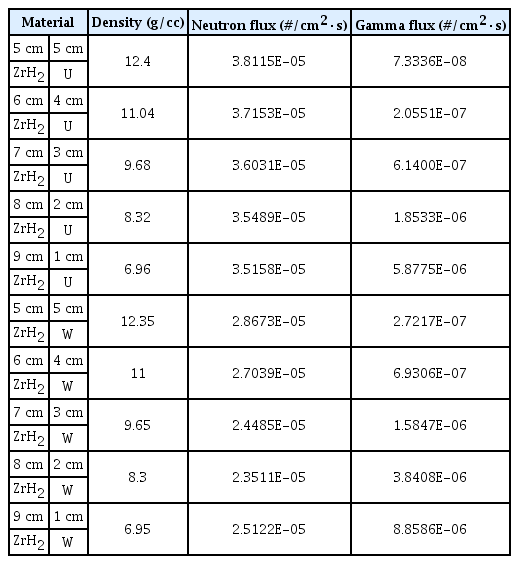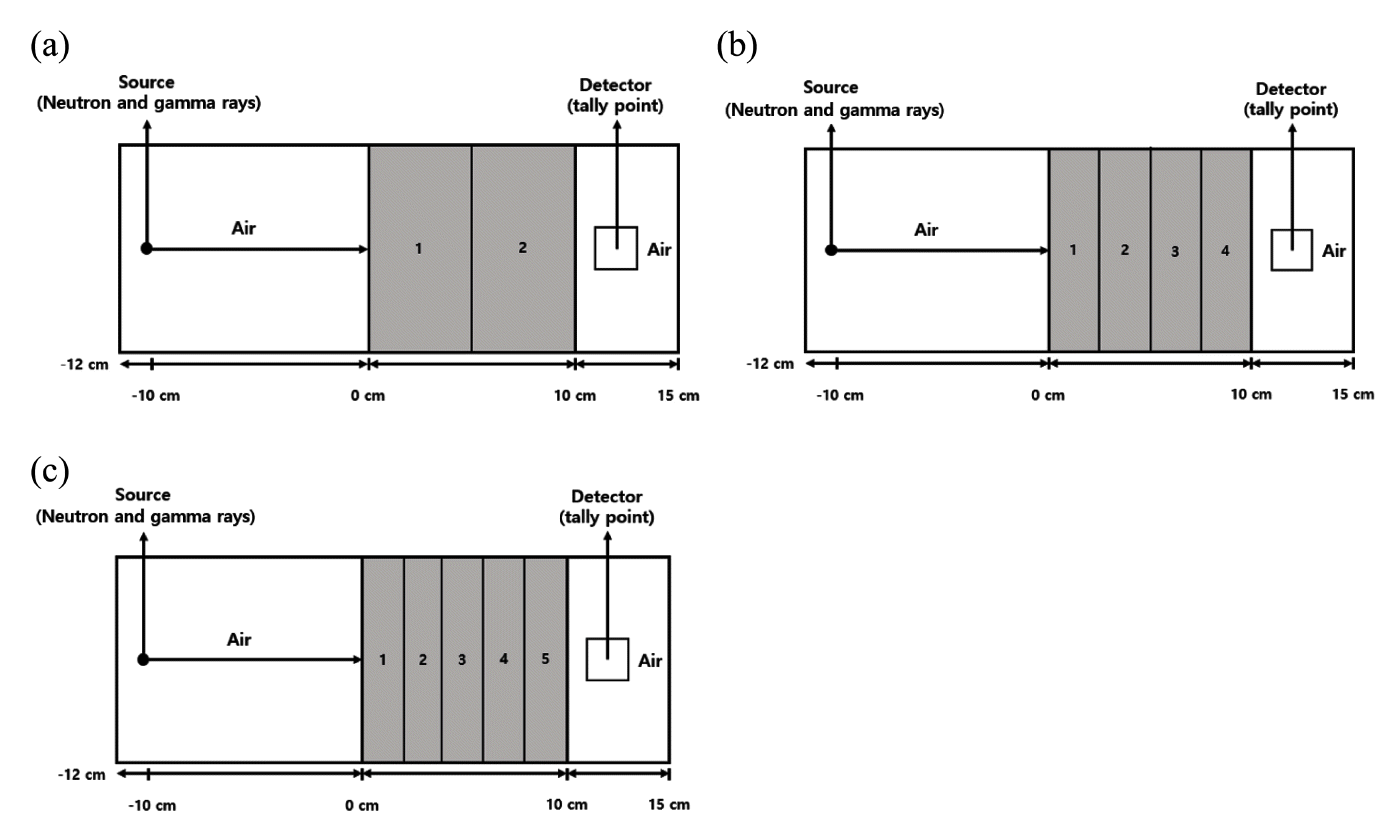Shielding Analysis of Metal Hydride-based Materials for Both Neutron and Gamma Rays Using Monte Carlo Simulation
Article information
Abstract
Radiation causes damage to the human body, the environment, and electronic equipment. Shielding against neutron and gamma rays is particularly difficult because of their strong ability to penetrate materials. Conventional gamma ray shields are typically made of materials containing Pb. However, they pose problems in that Pb is a heavy metal, and human poisoning and/or pollution can result from the manufacturing, use, and disposal of these materials. In addition, neutron rays are shielded by materials rich in H2 or concrete. In the case of the latter, the manufacturing cost is high. Thus, it is necessary to develop a new multilayer structure that can shield against both neutron and gamma rays. We set up a simulation model of a multilayered structure consisting of metal hydrides and heavy metals, and then evaluated the simulations using Monte Carlo N-Particle Transport Code. Monte Carlo simulation is an accurate method for simulating the interaction between radiation and materials, and can be applied to the transport of radiation particles to predict values such as flux, energy spectrum, and energy deposition. The results of the study indicated the multilayer structure of ZrH2, U, and W could shield both neutron and gamma rays, thus showing potential as a new shielding material to replace Pb and concrete.
1. Introduction
Nuclear accidents such as the 1986 accident in Chernobyl and the more recent one in Fukushima resulted in the massive release of radioactive materials into the environment. Not only did they pollute the soil and ocean, but they also caused fatal damage to humans as well as electronic equipment [1, 2]. In general, radiation comprises alpha, beta, and gamma rays. Alpha and beta rays have large retention energies but can be easily shielded against. Gamma rays and neutrons, in contrast, have high permeabilities and are difficult to be shielded against. Thus, they pose a relatively higher risk [3]. As a result, radiation shielding materials are required that can suitably shield and protect the human body and electronic equipment from radiation. In particular, shielding materials are essential in various fields of applications such as textiles, nuclear energy, aerospace, national defense, and medicine [4,5].
Conventional gamma ray shields are mainly made of materials containing Pb. High-density materials are effective at attenuating gamma rays, and they are generally produced using inexpensive Pb, such as an intact Pb plate or a film composed of Pb powder or PbS blended with an excess of polymer resin. However, shielding films containing Pb are heavy, and can cause human poisoning and/or pollution due to the presence of Pb during the manufacturing, use, and/or disposal processes [6,7]. For neutron beams, materials such as water, paraffin, and graphite have a high H2 content and a low atomic number, which slows down the fast neutron flux. Concrete mixed with materials such as B and Cd can be used to absorb decelerated neutron beams [8]. However, neutron beams and gamma rays have different attenuation characteristics with respect to shielding materials, and it is difficult to effectively shield against both kinds of rays using a single material. Thus, a multilayer structure is generally required. As the multilayer shielding material must be considerably thick, the manufacturing cost is high. In addition, the frequently contain harmful substances, such as Pb.
There have been many attempts to develop new shielding materials that can overcome the disadvantages of conventional neutron and gamma ray shielding materials. In the field of nuclear energy, radiation shielding experiments are simulated with a computer due to the prevailing limitations with suitable locations/facilities and equipment. Such simulations are typically carried out using the Monte Carlo N-Particle Transport Code (MCNP) [9,10]. The MCNP is known to be an accurate technique for simulating interactions between radiation and materials. It can be applied to study radiation particle transport and to predict values such as flux, energy spectra, and energy deposition. The MCNPX code is a representative program of the Monte Carlo method, and various studies on radiation shielding and protection have been carried out in Korea using this code [11-15]. Recently, MCNP6, which combines the functions of MCNP5 and MCNPX, was introduced. This code is known to be a more accurate and simpler model compared to both its predecessors [16-18].
2. Code description
2.1 Description of the simulation code and analysis model
The MCNP6 code was used for the simulation. The ENDF/B-VII.1 cross section library and Mcplib84 were used for the neutron ray calculations and gamma ray calculations, respectively. The source definition uses an F4 card, which detects the surface flux, and an F5 card, which detects the dotted flux. The analysis model targets a shielding material consisting of a regular hexahedron with sides of 10 cm each. Neutron and photon particles propagate in a straight line along the x-axis and enter the shielding material at 10 cm (Fig 1). The source and detector, except the shielding material, were simulated by artificially setting the air atmosphere to match the actual conditions. In this case, the size of the source energy ranged from 0.5 to 1 MeV, and the number of energy particles in the source was assumed to range from 107 to 108 photons or neutrons.
2.2 Description of the multilayer simulation model
We also set up a multilayer simulation model because of the secondary gamma rays generated when the shielding material is irradiated. Figure 2(a-c) is a schematic of a multilayer shielding analysis model. Parts (a), (b), and (c) show a simulation model consisting of two, four, and five layers, respectively. In the two-layer model, the first layer consists of a 5 cm thick metal hydride, and the second layer consists of a 5 cm thick heavy metal. In the four-layer model, the first and third layers consist of a 2.5 cm thick metal hydride, and the second and fourth layers consist of 2.5 cm thick heavy metals. In the five-layer model, the first, third, and fifth layers consist of a 2 cm thick metal hydride, and the second and fourth layers are composed of a 2 cm thick heavy metal.
3. Results
Table 1 and Table 2 show the multilayer shielding characterization data for combinations of 16 metal hydrides and heavy metals for neutron ray flux and gamma ray flux, respectively. In the single layer model, the neutron ray flux and gamma ray flux for concrete (2.25 g/cc) were observed to be 9.6695E-05 and 1.7372E-04, respectively. In the case of Pb (11.34 g/cc), the neutron ray flux and gamma ray flux were confirmed to be 8.2325E-05 and 2.5212E-07, respectively.

Neutron ray flux comparisons for the multilayer models (neutron/cm2·s) (relative error = 0.03 to 0.58).

Gamma ray flux comparisons for the multilayer models (photon/cm2·s) (relative error = 0.03 to 0.58).

Comparison of density, neutron ray flux, and gamma ray flux according to the thickness of ZrH2 and heavy metals (number/cm2·s) (relative error = 0.03 to 0.58).
In the multilayer model, the lowest neutron flux occurred for the TiH2/W multilayer model, while the lowest gamma flux was observed for multilayered structures containing ZrH2 and U. Overall, there was no difference between MgH2, TiH2, ZrH2, and Mg2FeH6 for neutron flux. On the other hand, for the gamma ray flux, it was found that adding W and U resulted in lower values than adding Hf and Tl. Therefore, for neutron beams, most of the multilayered structures exhibited shielding efficiencies similar to or higher than that of concrete, whereas all the multilayered structures showed good gamma ray shielding efficiencies when U was added.
In most cases, it was observed that the neutron ray flux and gamma ray flux increased as the number of layers increased. Considering both neutron and gamma rays, the two-layer structures of ZrH2/U and ZrH2/W showed excellent neutron beam and gamma ray shielding properties. In order to examine the differences in the shielding properties of ZrH2/U and ZrH2/W in detail, shielding property simulations were performed in terms of ratio difference.
The two-layer structure of ZrH2 and heavy metal showed better neutron shielding efficiency than that of concrete. In addition, ZrH2/W (thickness ratio: 5:5) showed a gamma ray shielding efficiency similar to that of Pb. In the case of U, the gamma ray shielding efficiency exceeded that of Pb at a thickness ratio of 6:4. For ZrH2/U (thickness ratio: 5:5), the shielding efficiency was 254% that of concrete for neutron rays and 344% that of Pb for gamma rays at 1 MeV. When using W, the corresponding numbers were 337% and 92.6% at 1 MeV. Here, the shielding efficiency was calculated based on the neutron ray flux and gamma ray flux of concrete and Pb. As a result, U, which has a higher density than W, showed excellent gamma ray shielding efficiency. As the thickness of the heavy metal increased, the gamma ray flux decreased.
4. Conclusion
In order to identify suitable shielding materials that can replace Pb and concrete, new materials were explored using the Monte Carlo simulation code MCNP6. A three-axis shielding model measuring 10 cm in each direction was set up, and the shielding properties of various metal hydridebased materials were evaluated and compared. The results showed that a single-layer shielding structure is disadvantageous as it does not shield the secondary gamma rays that are generated by the metal hydride. Shielding materials with a multilayered structure consisting of metal hydride and heavy metals exhibited shielding efficiencies equal to or better than those of existing shielding materials. In particular, a multilayer shield structure consisting of ZrH2/U and ZrH2/W showed neutron ray and gamma ray shielding efficiencies of 254 and 337% of those of concrete, and 344 and 92.6% of those of Pb, respectively, at 1 MeV. Thus, these multilayers can be used to replace concrete and Pb as neutron and gamma ray shielding materials in nuclear reactors and thermocouples.
Notes
Author Contributions
The manuscript was written with contributions from all authors. All authors have given approval to the final version of the manuscript.
The authors declare no competing financial interest.
Data Availability
All the authors agree to provide the datasets generated during and/or analyzed during the current study on reasonable request.
Acknowledgements
This work was supported by Radiation Technology R&D program through the National Research Foundation of Korea funded by the Ministry of Science and ICT (NRF-2017M2A2A4A01071249).

